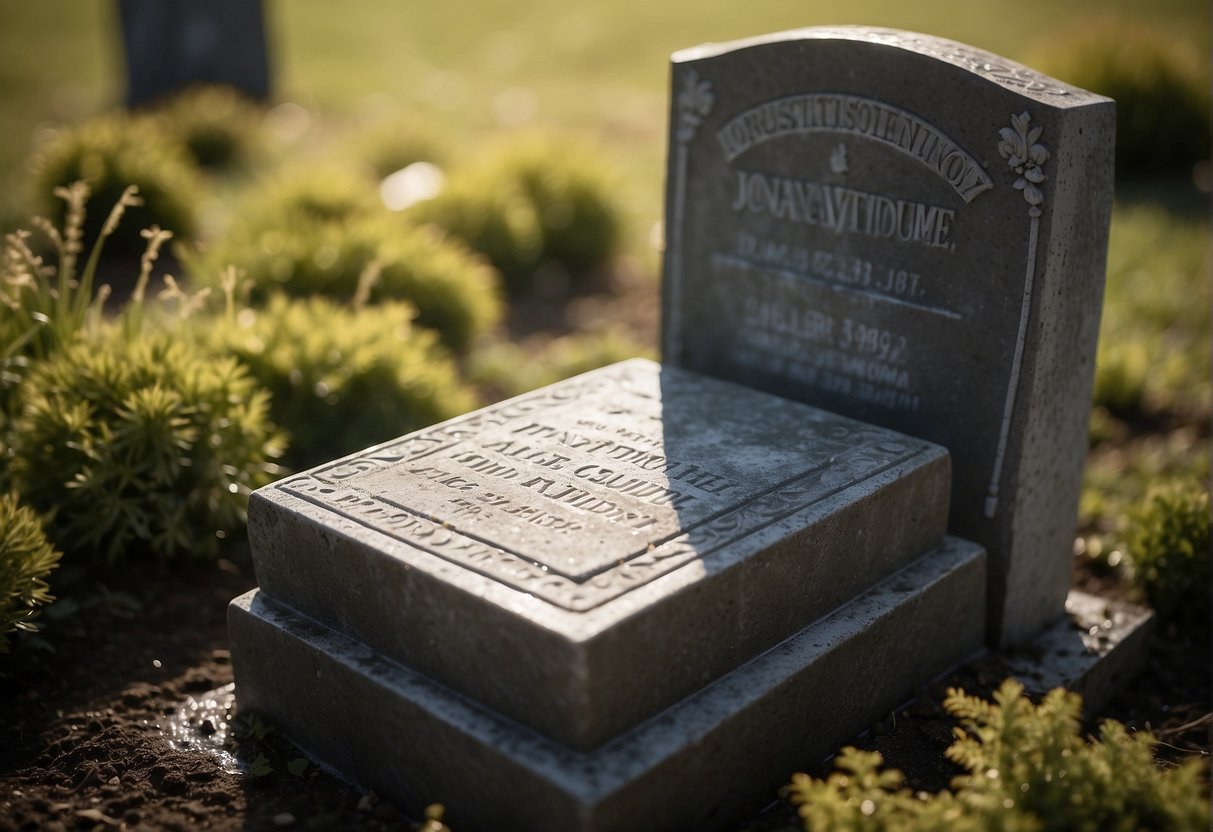Cleaning a gravestone serves as a poignant tribute to commemorate the legacy of a departed family member or friend, ensuring their memorial remains preserved for future generations. Upon visiting a graveyard, it’s common to observe that many tombstones show signs of wear due to the elements and the passage of time. By tending to yours, it can remain distinct and legible, serving as a sincere homage amidst the grounds of memory.
Preparing for Cleaning

Before you embark on the noble task of cleaning a gravestone, ensuring you have the right materials and knowledge is key. You’ll need to assess the gravestone’s condition and understand its material to select the appropriate cleaning tools and techniques.
Gathering Materials
Your cleaning toolkit should consist of:
- Brushes: Stick to soft bristle brushes to avoid scratching the stone.
- Cleaning Supplies: Prepare non-ionic detergents as they are gentle on gravestones.
- Water: Plenty of clean water is essential; temperature-wise, room temperature is your best bet.
- Bucket: For carrying water and mixing your cleaning solution.
- Sponge: Handy for gentle cleaning action.
- Gloves: Protect your hands while you work.
Remember, no wire brushes as they can damage the gravestone’s surface!
Understanding Gravestone Material
Gravestones can be made from a range of materials, such as granite, marble, or limestone. Each type requires different care:
- Granite: Durable and less porous, it withstands harsher cleaning.
- Marble/Limestone: Softer and more porous, demanding a very mild cleaning approach.
Knowing this ensures you don’t use techniques that could harm the grave marker.
Assessing The Gravestone Condition
Take a moment to carefully check the gravestone’s condition. Look for signs of:
- Cracking
- Flaking
- Biological growth (like moss or lichen)
If the stone is unstable, it might be best to consult a professional restorer. Always secure permission from the relevant authorities before you begin; some cemeteries have strict guidelines. Lastly, choose a day with mild weather to ensure the cleaning process is effective and that your materials aren’t adversely affected by the elements.
The Cleaning Process

Embarking on the journey to rejuvenate the cherished memorials of loved ones, you’ll navigate through gentle wet cleaning methods, the safe removal of natural buildups like lichens, and the final steps to ensure a lasting, respectful finish.
Wet Cleaning Technique
Start with a soft bristle brush or natural sponges and room-temperature water; hot water could harm the stone. Wet the gravestone thoroughly before applying a mild, non-ionic detergent — safe for any material, whether it’s granite, marble, sandstone, slate, or bronze. Gently scrub in a circular motion, giving special care to textured or engraved areas where dirt can hide.
Dealing With Organic Growth
For lichen, moss, or algae, they’re not just unsightly but can affect the stone’s stability over time. Dampen the growth and softly pick away at these invaders with your brush. This method is preferred as opposed to harsh chemicals, safeguarding the gravestone’s natural patina while maintaining the integrity of more sensitive stones like marble or sandstone.
Drying and Final Touches
Once you rinse the stone with clean water, use towels to pat the surface dry. This isn’t just about appearance; it’s also about preventing new growths from the lingering moisture. If you’re dealing with bronze, applying a thin layer of paste wax can enhance the weather resistance, ensuring that your hard work stands the test of time. Remember, regular care can protect these historical markers, allowing them to signify respect and remembrance for years to come.
Frequently Asked Questions

Before diving into the details of gravestone maintenance, let’s address some common queries to ensure you’re cleaning these memorials correctly and respectfully. Often, a bit of knowledge can prevent irreversible damage and honor the memory of the departed with the care they deserve.
What is the safest method for cleaning a gravestone without causing damage?
To safeguard a gravestone’s integrity while cleaning, use a soft-bristled brush and plain water to gently scrub the surface. Steer clear of hot water and ensure any cleaner you use is non-acidic to prevent damage to the stone.
Is it possible to create an effective cleaner for headstones at home?
Yes, you can make a headstone cleaner at home using gentle, non-ionic detergents mixed with water. However, confirm that the solution is suitable for the type of headstone you are cleaning to avoid any harm.
What are the legal considerations when cleaning someone else’s gravestone?
Always obtain permission from the cemetery management before cleaning any gravestone that does not belong to your family. This respects both legal boundaries and the wishes of other families.
Which commercial cleaners are recommended for headstone maintenance?
Commercial cleaners such as D/2 Biological Solution are often recommended for headstone maintenance as they are specifically formulated to be gentle on stone while effectively removing biological growth and stains.
Can household items like Dawn dish soap be used to safely polish headstones?
Dawn dish soap, or similar gentle liquid dish detergents, can be used in minimal amounts to assist in cleaning headstones; just ensure it’s thoroughly rinsed off to avoid leaving any residue.
Are natural solutions such as vinegar or baking soda recommended for headstone cleaning purposes?
It’s advisable to avoid vinegar or baking soda for headstone cleaning as their acidic and abrasive qualities, respectively, can etch or scratch certain stone types, leading to potential damage.


